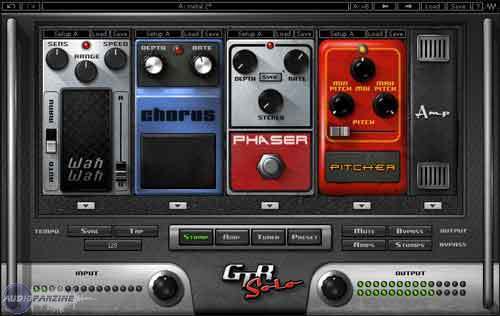Octave dividers aren’t just for guitar players: They also rock for bass, whether you’re getting mega-low sounds from the lower strings, or playing high up on the neck for very cool 8-string bass effects. It’s easy to do octave division with amp sims and DAWs, but there are some definite tricks involved.
Split Your Signal
As when adding many other types of effects on bass, it’s best to create a second track in parallel with the main bass sound, and dedicate the second track to the octave divider. This lets you mix in the precise amount of octave sound, but more importantly, you may need to condition the bass signal to optimize it for octave division.
Choose Your Divider
Most amp sims include octave dividers.
Fig. 1: Waves’ GTR|Solo is set up for octave division on bass. The Pitcher module provides the octave division; its Mix control is set to divided sound only.
I’ve successfully used octave dividers on bass with IK Multimedia AmpliTube, Waves GTR Solo (Fig. 1) and GTR3, Native Instruments Guitar Rig (Fig. 2), and Peavey ReValver Mk III.
Fig. 2 (click to enlarge): Guitar Rig’s Pro-Filter module is an excellent EQ for conditioning a bass signal before it hits the Oktaver; this screen shot is from Guitar Rig 3.
There’s not a lot of difference among these effects for this particular task; they all do the job. You can also use other available modules to condition the bass signal.
Pre-Octave Processing
Two main problems can interfere with proper triggering: An inconsistent input signal level, and triggering on a harmonic rather than the fundamental (which causes an “octave-hopping” effect, where the signal jumps back and forth between the fundamental and octave).
A compressor can solve the consistency problem. Set it for a moderate amount of compression (e.g., 4:1 ratio, with a fairly high threshold). Make sure the compressed sound doesn’t have a “pop” at the beginning, and the sustain is smooth. Then if needed, patch in an EQ to take off some of the highs—the object is to emphasize the fundamental. This may require compromise; too much filtering will reduce the level from the higher strings to where they might not be able to trigger the octave divider (as well as change the tone), whereas not filtering enough may cause octave-hopping on the lower strings.
What works best for me is cutting highs and boosting the low bass a bit. If the EQ curve isn’t sharp enough, you may get better results by patching two EQs in series. I’ve also found that with Guitar Rig, using the Pro Filter module with mode set to LPF (lowpass) and slope to 100% four-pole provides outstanding conditioning, especially when preceded by the Tube Compressor.
The Final Touch
Playing technique also matters. Popping and snapping might confuse the octave divider, as can the transients that occur from playing with a pick. Playing with your fingers or thumb gives the best results, but don’t be afraid to experiment; for example, if you do “snap” the string, the sound might mask the divided sound anyway, so it won’t matter. Also, remember that octave dividers are monophonic, so make sure only one string vibrates at a time.
Once you have your signal chain tweaked, adjust the parallel, octave-divided signal for the right balance with the main bass signal. You’ll probably find yourself playing an octave higher than normal, because the octave divider will supply the low fundamental. But octave division is also a great way to make those low strings create seismic-type lows that throb in a way you can’t get any other way.
This article was originally published on Harmony Central. Reprinted with permission.

